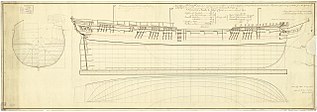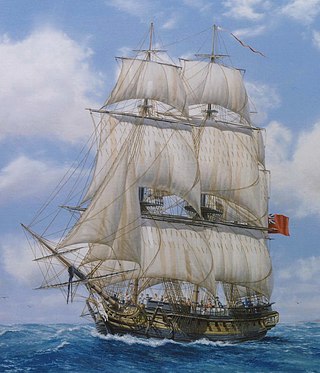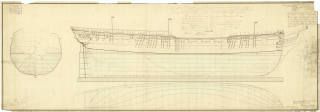
HMS Galatea was a fifth-rate 32-gun sailing frigate of the British Royal Navy that George Parsons built at Bursledon and launched in 1794. Before she was broken up in 1809 she captured numerous prizes and participated in a number of actions, first in the Channel and off Ireland (1794–1803), and then in the Caribbean (1802–1809), including one that earned her crew the Naval General Service Medal.

HMS Indefatigable was one of the Ardent-class 64-gun third-rate ships-of-the-line designed by Sir Thomas Slade in 1761 for the Royal Navy. She was built as a ship-of-the-line, but most of her active service took place after her conversion to a 44-gun razee frigate. She had a long career under several distinguished commanders, serving throughout the French Revolutionary Wars and the Napoleonic Wars. She took some 27 prizes, alone or in company, and the Admiralty authorised the issue of four clasps to the Naval General Service Medal in 1847 to any surviving members of her crews from the respective actions. She was broken up in 1816.

HMS Naiad was a Royal Navy fifth-rate frigate that served in the Napoleonic Wars. She was built by Hall and Co. at Limehouse on the Thames, launched in 1797, and commissioned in 1798. She served in the French Revolutionary and Napoleonic Wars, and her last actions occurred in 1824–5. She was paid off in 1826. She then served for many years in Latin America as a coal depot, first for the Royal Navy and then for the Pacific Steam Navigation Company. She was broken up in 1898, 101 years after her launching.

HMS Amazon, was a 36-gun Amazon-class frigate, built at Rotherhithe in 1795 to a design by Sir William Rule. Carrying a main battery of 18-pounder long guns, she was the first of a class of four frigates. She had a short but eventful career during the French Revolutionary War, which she spent in the Channel and Western Approaches, part of a frigate squadron under Sir Edward Pellew. She was wrecked in Audierne Bay in 1797, following an action on 13 January with the French ship-of-the-line, Droits de l'Homme.

Révolutionnaire, was a 40-gun Seine-class frigate of the French Navy, launched in May 1794. The British captured her in October 1794 and she went on to serve with the Royal Navy until she was broken up in 1822. During this service Revolutionnaire took part in numerous actions, including three for which the Admiralty would in 1847 award clasps to the Naval General Service Medal, and captured several privateers and merchant vessels.

Pomone was a 40-gun frigate of the French Navy, launched in 1785. The British captured her off the Île de Batz in April 1794 and incorporated her into the Royal Navy. Pomone subsequently had a relatively brief but active career in the British Navy off the Atlantic and Mediterranean coasts of France before suffering sufficient damage from hitting a rock to warrant being taken out of service and then broken up in 1803.

HMS Melampus was a Royal Navy fifth-rate frigate that served during the French Revolutionary and Napoleonic Wars. She captured numerous prizes before the British sold her to the Royal Netherlands Navy in 1815. With the Dutch, she participated in a major action at Algiers and, then, in a number of colonial punitive expeditions in the Dutch East Indies.

The action of 13 January 1797 was a minor naval battle fought between a French ship of the line and two British frigates off the coast of Brittany during the French Revolutionary Wars. During the action the frigates outmanoeuvred the much larger French vessel and drove it onto shore in heavy seas, resulting in the deaths of between 400 and 1,000 of the 1,300 persons aboard. One of the British frigates was also lost in the engagement with six sailors drowned after running onto a sandbank while failing to escape a lee shore.

HMS Hazard was a 16-gun Royal Navy Cormorant-class ship-sloop built by Josiah & Thomas Brindley at Frindsbury, Kent, and launched in 1794. She served in the French Revolutionary Wars and throughout the Napoleonic Wars. She captured numerous prizes, and participated in a notable ship action against the French frigate Topaze, as well as in several other actions and campaigns, three of which earned her crew clasps to the Naval General Service Medal. Hazard was sold in 1817.
The hired armed cutter Black Joke was a cutter that served the Royal Navy from 12 January 1795 to 19 October 1801. In 1799 she was renamed Suworow, and under that name she captured numerous prizes before she was paid off after the Treaty of Amiens.
HMS Nemesis was a 28-gun Enterprise-class sixth-rate frigate of the Royal Navy. The French captured her in 1795 at Smyrna, but in 1796 a squadron led by Barfleur brought her out of the neutral port of Tunis. Throughout her career she served under a number of commanders who would go on to have distinguished careers. She was converted to a troopship in 1812 and was sold in 1814.

Gracieuse was a 32-gun Charmante-class frigate of the French Navy. Renamed to Unité in 1793, she took part in the French Revolutionary Wars. The Royal Navy captured her in 1796 off Île d'Yeu and brought her into British service as HMS Unite. She was sold in 1802

His Majesty's hired armed cutter Telemachus served the Royal Navy from 17 June 1795 until 15 January 1801. She was of 1285⁄95 tons (bm), and carried fourteen 4-pounder guns. During her five and a half years of service to the Royal Navy she captured eight French privateers as well as many merchant vessels.

HMS Childers was a brig-sloop of the British Royal Navy, initially armed with 10 carriage guns which were later increased to 14 guns. The first brig-sloop to be built for the Navy, she was ordered from a commercial builder during the early years of the American War of Independence, and went on to support operations in the English Channel and the Caribbean. Laid up for a time after the end of the American War of Independence, she returned to service shortly before the outbreak of the French Revolutionary Wars. She had an active career in both the French Revolutionary and Napoleonic Wars, capturing numerous French privateers and during the Gunboat War participated in a noteworthy single-ship action. The navy withdrew her from service at the beginning of 1811, at which time she was broken up.

The French brig Suffisante was launched in 1793 for the French Navy. In 1795 the Royal Navy captured her and took her into service under her existing name. HMS Suffisante captured seven privateers during her career, as well as recapturing some British merchantmen and capturing a number of prizes, some of them valuable. She was lost in December 1803 when she grounded in poor weather in Cork harbour.

HMS Eugenie was the French privateer Nouvelle Eugénie, launched at Nantes in 1796 that the British Royal Navy captured in 1797 and took into service. As a brig-sloop she served in the Channel, primarily escorting convoys, and was sold in 1803.
HMS Growler was a Archer-class gun-brig built for the British Royal Navy and launched in 1804. She captured several French privateers and one Danish privateer, and took part in two actions that earned her crew the Naval General Service Medal (NGSM). She was sold in 1815.

HMS Artois was a fifth-rate Artois-class frigate of the Royal Navy, designed by Sir John Henslow and launched in 1794 at Rotherhithe as the lead ship of her class. She served for the majority of her career in the English Channel under the command of Edmund Nagle in the squadrons of Edward Pellew and John Borlase Warren, notably taking part in the action of 21 October 1794 where she captured the 44-gun frigate La Révolutionnaire almost singlehandedly. She participated in a number of other actions and events including the attempted invasion of France in 1795. Artois continued to serve actively on the coast of France in blockade and patrolling roles, taking a large number of ships as prizes, until she was wrecked with no loss of life off Île de Ré on 31 July 1797 while attempting to reconnoitre the harbour of La Rochelle.
Betzy was the Channel Islands brig Betsey that the French frigate Sémillante captured in May 1793, that the French Navy took into service, and that the Royal Navy recaptured in 1796.
HMS Conflict was launched in 1805. She captured a number of vessels, including privateers, and participated in several major actions. She disappeared in November 1810 with the loss of all her crew.














